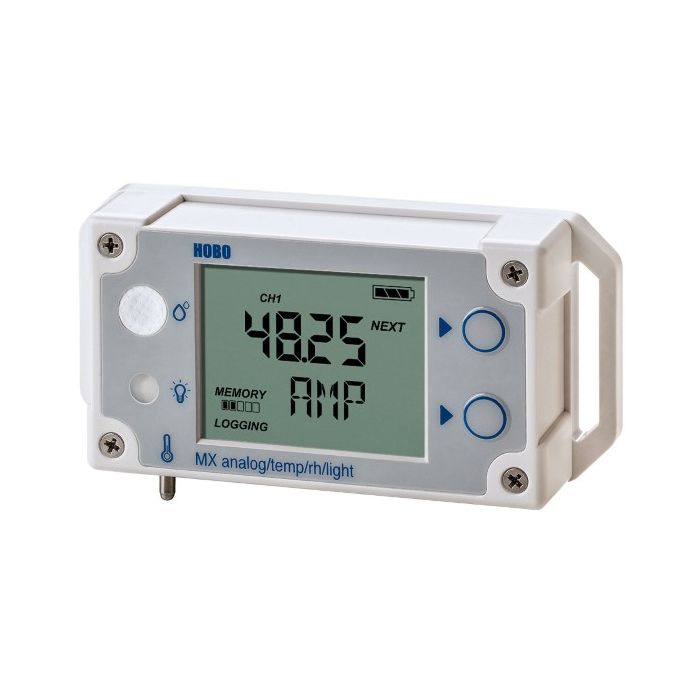HOBO Multi-Channel Data Loggers
The HOBO MX multi-channel data loggers measure and transmit data wirelessly from indoor environments to a mobile device or computer using Bluetooth Low Energy technology.
Features
- External analog input for a variety of additional sensors
- Optional self-describing sensors with automatic configuration
- Connect via Bluetooth within 100 feet
- Expedited repair and warranty service
- Lifetime technical support
- More
Overview
The HOBO MX Analog/Temp/RH/Light (MX1104) and HOBO MX 4-Channel Analog (MX1105) data loggers measure and transmit data wirelessly from indoor environments to a mobile device or computer using Bluetooth Low Energy technology.
Mechanics
The MX1104 model has integrated temperature, relative humidity (RH), and light intensity sensors and one analog input, while the MX1105 model has four analog inputs. Both models support a wide variety of external sensors (sold separately), including self-describing temperature, split-core AC current transformer, 4-20 mA input, and DC voltage input sensors.
Design
The self-describing sensors are designed with integrated strain relief for a secure connection to the loggers and are automatically detected by the HOBOconnect app for easy setup. These compact loggers also have built-in LCD screens to display current sensor readings, logging status, battery use, memory consumption, and more.
Data Retrieval
Using the app, users can configure the loggers, read out and view data, and export the data for further analysis. The loggers can calculate minimum, maximum, average, and standard deviation statistics and can also be configured to trip audible or visual alarms at thresholds users specify. In addition, both loggers support burst logging, in which data is logged at a different interval when sensor readings are above or below certain limits.
| Temperature Sensor (MX1104) | |||||
| Range | -20° to 70°C (-4° to 158°F) | ||||
| Accuracy | ±0.20°C from 0° to 50°C (±0.36°F from 32° to 122°F) | ||||
| Resolution | 0.002°C at 25°C (0.004°F at 77°F) | ||||
| Drift | <0.1°C (0.18°F) per year | ||||
| RH Sensor* (MX1104) | |||||
| Range | 0% to 100% at -20° to 70°C (-4° to 158°F); exposure to conditions above 95% may temporarily increase the maximum RH sensor error by an additional 1% | ||||
| Accuracy | ±2.5% from 10% to 90% (typical) to a maximum of ±3.5% including hysteresis at 25°C (77°F); below 10% and above 90% ±5% typical | ||||
| Resolution | 0.01% | ||||
| Drift | <1% per year typical | ||||
| Response Time (MX1104) | |||||
| Temperature | 11 minutes in air moving 1 m/s (2.2 mph) | ||||
| RH | 30 seconds to 90% in airflow of 1 m/s (2.2 mph) | ||||
| Light Sensor (M1104) | |||||
| Range | 0 to 167,731 lux (15,582 lum/ft2) | ||||
| Accuracy | ±10% typical for direct sunlight (see Light Measurement on page 4 for more details) | ||||
| Logger with Cable Type |
SD-MA-420 or CABLE-4-20mA | SD-VOLT-2.5 or CABLE-2.5-STEREO | SD-VOLT-05 or CABLE- ADAP5 |
SD-VOLT-10 or CABLE-ADAP10 | SD-VOLT-24 or CABLE-ADAP24 |
| Measurement Range | 0 to 20.1 mA | 0 to 2.5 V | 0 to 5.0 V | 0 to 10 V | 0 to 24 V |
| Accuracy | ±0.001 mA ±0.2% of reading | ±0.1 mV ±0.1% of reading | ±0.2 mV ±0.3% of reading | ±0.4 mV ±0.3% of reading | ±1.0 mV ±0.3% of reading |
| Resolution | 0.3 µA | 40 µV | 80 µV | 160 µV | 384 µV |
| Logger | |||||
| Operating Range | -20° to 70°C (-4° to 158°F) | ||||
| Radio Power | 1 mW (0 dBm) | ||||
| Transmission Range | Approximately 30.5 m (100 ft) line-of-sight | ||||
| Wireless Data Standard | Bluetooth Low Energy (Bluetooth Smart) | ||||
| Logging Rate | 1 second to 18 hours | ||||
| Logging Modes | Fixed interval (normal, statistics) or burst | ||||
| Memory Modes | Wrap when full or stop when full | ||||
| Start Modes | Immediate, push button, date & time, or next interval | ||||
| Stop Modes | When memory full, push button, date & time, or after a set logging period | ||||
| Restart Mode | Push button | ||||
| Time Accuracy | ±1 minute per month at 25°C (77°F) | ||||
| Battery Type | Two AAA 1.5 V alkaline batteries, user replaceable | ||||
| Battery Life | 1 year, typical with logging interval of 1 minute and Bluetooth Always On enabled; 2 years, typical with logging interval of 1 minute and Bluetooth Always On disabled; and temperatures between 0° and 50°C (32° and 122°F). Faster logging intervals and statistics sampling intervals, burst logging, remaining connected with the app, excessive downloads, and paging may impact battery life. | ||||
| Memory | 4 MB (1.9 million measurements, maximum) | ||||
| Full Memory Download Time | Approximately 4 to 15 minutes depending on the mobile device; may take longer the further the device is from the logger | ||||
| LCD | LCD is visible from 0° to 50°C (32° to 122°F); the LCD may react slowly or go blank in temperatures outside this range | ||||
| Size | 11.28 x 5.41 x 2.92 cm (4.44 x 2.13 x 1.15 in.) | ||||
| Weight | 123 g (4.34 oz) | ||||
| Environmental Rating | IP54 | ||||
In The News
























